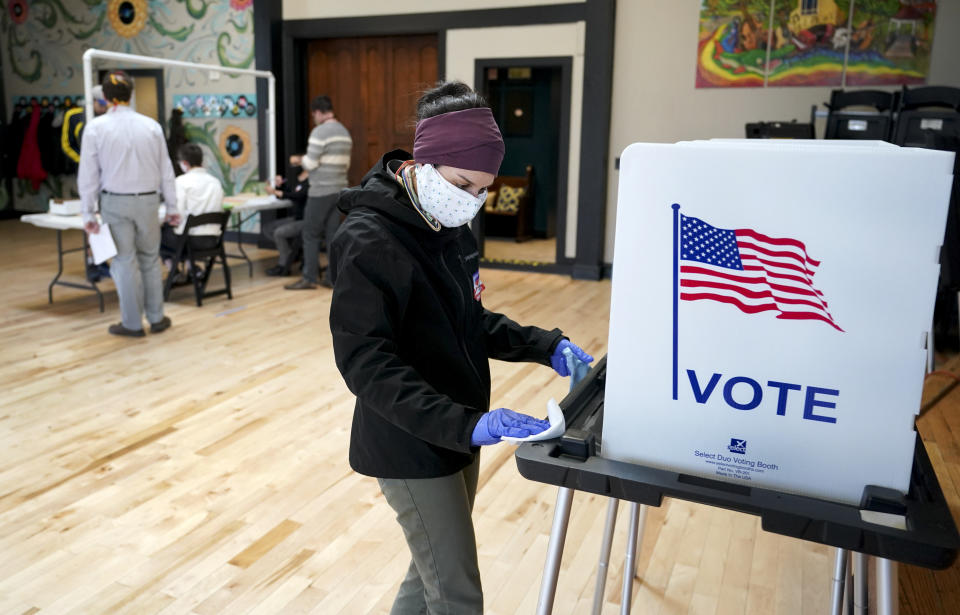Trump's candidate loses in Wisconsin, despite help from courts
Last week, Republican officials and conservative judges pushed for Wisconsin to have in-person voting even though the state was in the middle of a public health emergency with the coronavirus pandemic. It led to some absurd visuals, such as Wisconsin state Assembly Speaker Robin Vos, a leading GOP figure, telling voters it was safe to go to the polls even as he was protected by a mask, goggles and a gown.
The reason for their focus on the race was protecting a state Supreme Court seat held by conservative Justice Daniel Kelly. With a competitive Democratic primary also on the April ballot, the push to have an election despite warnings to avoid large gatherings was seen as an attempt to suppress the vote, particularly in the Democratic stronghold of Milwaukee. In the state’s largest city, just five of the usual 180 polling places were open, leading to hours-long waits for voters. An attempt by Democratic Gov. Tony Evers to delay in-person voting by executive order was overturned by the state Supreme Court, with the four conservative justices outvoting the two liberal justices and Kelly abstaining.
The United States Supreme Court also ruled against the Democrats, with the five Republican-appointed justices voting on the eve of the Wisconsin election to strike down a six-day extension for returning absentee ballots. The four Democratic appointees dissented.
Despite the court rulings and vocal support from President Trump, when the results were announced Monday Kelly failed to retain his seat, losing by 11 points to progressive challenger Jill Karofsky. Every state Supreme Court justice voted absentee, including the four who had ruled against delaying in-person voting.

Trump seemed to respond to the results Tuesday morning between attacks on the country’s governors for questioning his authority as president.
“GET RID OF BALLOT HARVESTING, IT IS RAMPANT WITH FRAUD. THE USA MUST HAVE VOTER I.D., THE ONLY WAY TO GET AN HONEST COUNT!” tweeted Trump, overlooking the fact that in Wisconsin absentee ballots are required to include a photocopy of a person’s identification card, and there has been no evidence of wide-scale or organized fraud involving mail-in votes.
There is a push by Democrats for nationwide voting by mail to be implemented in advance of November’s general election as a backup plan if the coronavirus is still making in-person voting a public health hazard. (Poll workers from Florida and Illinois have died of COVID-19 after working the two states’ March 17 primaries.) Trump has resisted, claiming the practice is ripe for fraud despite evidence to the contrary, including the fact that a number of states already use vote-by-mail. Trump himself voted by mail in last month’s Florida primary.
Last month, Trump directly stated that an increase in voting would hurt his party, saying proposed reforms would result in “levels of voting, that if you ever agreed to it you’d never have a Republican elected in this country again.”
The ballot harvesting Trump alluded to in his tweet is the process of an organizer or volunteer collecting ballots. There is one recent instance of ballot harvesting altering an election, but it wasn’t to the benefit of Democrats. In 2018, an operative working for GOP congressional candidate Mark Harris tampered with ballots in the race for North Carolina’s Ninth Congressional District. The results, in which Harris led by 905 votes over Democrat Dan McCready, were never certified by the state’s election board. A new election was held in September 2019, and McCready lost narrowly to Dan Bishop, a GOP state senator.
When Trump was asked about the fraud in February 2019, he said, “I condemn any election fraud” before pivoting to accusing Democrats of ballot tampering.
Trump and his administration have pushed the conspiracy theory that there were millions of illegal votes in California to explain why he lost the national popular vote to Hillary Clinton in 2016. Republicans have raised suspicions about the results of the 2018 midterms, when election-night leads by some GOP candidates evaporated after additional ballots were counted. There is no evidence historically to support Trump’s assertion, and multiple studies have found instances of voting fraud to be vanishingly small. A comprehensive 2014 report examining years of elections turned up 31 instances of credible fraud out of 1 billion votes cast. A survey of news reports after the 2016 election by the Washington Post turned up four reported instances. In February 2017, White House adviser Stephen Miller told ABC News there was evidence that voters from other states were bused into New Hampshire. So far the administration has not provided such evidence.
In May 2017, the president set up a commission to investigate voter fraud, which disbanded less than a year later without issuing a report.
_____
Click here for the latest coronavirus news and updates. According to experts, people over 60 and those who are immunocompromised continue to be the most at risk. If you have questions, please refer to the CDC’s and WHO’s resource guides.
Read more:




